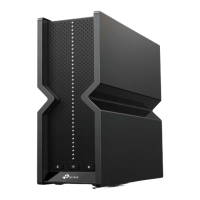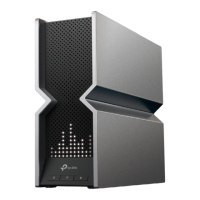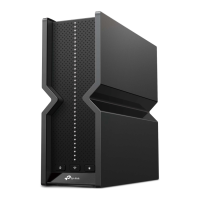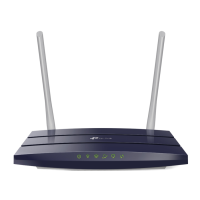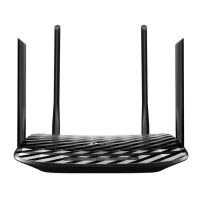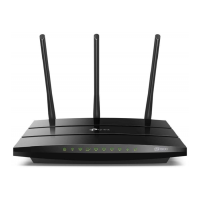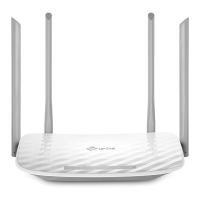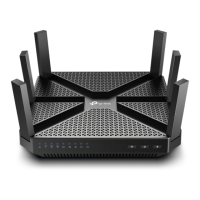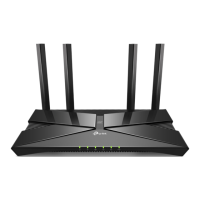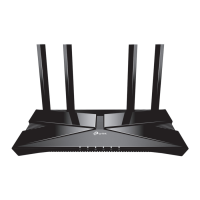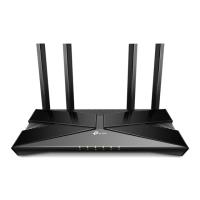Do you have a question about the TP-Link Archer BE900 and is the answer not in the manual?
Details the Wi-Fi 7 technology, 6 GHz band, and performance improvements of the router.
Describes the front and back panel components, including the LED screen and touchscreen.
Guidelines for optimal router placement to avoid moisture, heat, and interference.
Steps for connecting the router to the internet via Ethernet or fiber and powering it on.
Guides for setting up internet via Quick Setup Wizard, Tether App, or manual configuration.
Setting up the router as an Access Point or configuring IPv6 internet connections.
Registering, changing, and managing TP-Link IDs for router access and cloud services.
Using the TP-Link Tether app for convenient router management on mobile devices.
Customizing SSID, password, security, transmit power, and channel settings.
Configuring wireless scheduling, WPS, advanced parameters, and Wi-Fi on/off.
Steps to enable and configure a guest Wi-Fi network, including SSID and bandwidth control.
Setting guest permissions to allow or restrict communication between guest devices.
Accessing files on connected USB devices locally or remotely via network shares.
Streaming photos, music, and videos from USB storage to DLNA-compatible devices.
Configuring Time Machine backups for Mac computers to a connected USB storage device.
Scanning the network for performance and security optimization, identifying risks.
Using Parental Controls, QoS, and other features for network security and management.
Adding another TP-Link router to the EasyMesh network as a satellite device.
Adding a TP-Link range extender to the EasyMesh network as a satellite device.
Viewing and managing mesh devices and connected clients within the EasyMesh network.
Configuring SPI Firewall, Access Control (blacklist/whitelist), and IP & MAC Binding for network defense.
Managing ALG settings and isolating IoT devices to enhance network security.
Configuring port forwarding for sharing resources and port triggering for dynamic port opening.
Setting up DMZ for unlimited communication and enabling UPnP for applications like online gaming.
Setting up OpenVPN, PPTP, L2TP/IPSec, and WireGuard servers for secure remote access.
Configuring the router to act as a VPN client to connect to remote VPN servers.
Modifying internet port, connection types, and router's LAN IP address settings.
Configuring Link Aggregation, IPTV support, DHCP server, Dynamic DNS, and Static Routes.
Updating firmware, backing up/restoring configurations, changing passwords, and password recovery.
Configuring local/remote management, system logs, network testing, and system time settings.
Scheduling regular reboots and controlling router LED behavior for optimal performance.
Addresses common issues like forgotten passwords, login problems, no internet access, and wireless connection failures.
Details the Wi-Fi 7 technology, 6 GHz band, and performance improvements of the router.
Describes the front and back panel components, including the LED screen and touchscreen.
Guidelines for optimal router placement to avoid moisture, heat, and interference.
Steps for connecting the router to the internet via Ethernet or fiber and powering it on.
Guides for setting up internet via Quick Setup Wizard, Tether App, or manual configuration.
Setting up the router as an Access Point or configuring IPv6 internet connections.
Registering, changing, and managing TP-Link IDs for router access and cloud services.
Using the TP-Link Tether app for convenient router management on mobile devices.
Customizing SSID, password, security, transmit power, and channel settings.
Configuring wireless scheduling, WPS, advanced parameters, and Wi-Fi on/off.
Steps to enable and configure a guest Wi-Fi network, including SSID and bandwidth control.
Setting guest permissions to allow or restrict communication between guest devices.
Accessing files on connected USB devices locally or remotely via network shares.
Streaming photos, music, and videos from USB storage to DLNA-compatible devices.
Configuring Time Machine backups for Mac computers to a connected USB storage device.
Scanning the network for performance and security optimization, identifying risks.
Using Parental Controls, QoS, and other features for network security and management.
Adding another TP-Link router to the EasyMesh network as a satellite device.
Adding a TP-Link range extender to the EasyMesh network as a satellite device.
Viewing and managing mesh devices and connected clients within the EasyMesh network.
Configuring SPI Firewall, Access Control (blacklist/whitelist), and IP & MAC Binding for network defense.
Managing ALG settings and isolating IoT devices to enhance network security.
Configuring port forwarding for sharing resources and port triggering for dynamic port opening.
Setting up DMZ for unlimited communication and enabling UPnP for applications like online gaming.
Setting up OpenVPN, PPTP, L2TP/IPSec, and WireGuard servers for secure remote access.
Configuring the router to act as a VPN client to connect to remote VPN servers.
Modifying internet port, connection types, and router's LAN IP address settings.
Configuring Link Aggregation, IPTV support, DHCP server, Dynamic DNS, and Static Routes.
Updating firmware, backing up/restoring configurations, changing passwords, and password recovery.
Configuring local/remote management, system logs, network testing, and system time settings.
Scheduling regular reboots and controlling router LED behavior for optimal performance.
Addresses common issues like forgotten passwords, login problems, no internet access, and wireless connection failures.
| DSL WAN | No |
|---|---|
| Ethernet WAN | Yes |
| WAN connection type | RJ-45 |
| Product type | Tabletop router |
| Product color | Black, Grey |
| Modulation | 4096-QAM |
| Wi-Fi band | Quad-band (2.4 GHz / 5 GHz-1 / 5 GHz-2 / 6 GHz) |
| Wi-Fi standards | 802.11a, 802.11b, 802.11g, Wi-Fi 4 (802.11n), Wi-Fi 5 (802.11ac), Wi-Fi 6 (802.11ax), Wi-Fi 6E (802.11ax), Wi-Fi 7 (802.11be) |
| Top Wi-Fi standard | Wi-Fi 7 (802.11be) |
| WLAN data transfer rate (max) | 24000 Mbit/s |
| WLAN data transfer rate (first band) | 1376 Mbit/s |
| WLAN data transfer rate (second band) | 5760 Mbit/s |
| VPN server | OpenVPN, PPTP, L2TP, WireGuard |
| Networking standards | IEEE 802.1x |
| Ethernet LAN data rates | 1000, 2500, 10000 Mbit/s |
| Ethernet LAN interface type | Multi-Gigabit Ethernet |
| Number of guest networks (5 GHz) | 2 |
| Number of guest networks (2.4 GHz) | 1 |
| USB 2.0 ports quantity | USB 2.0 ports have a data transmission speed of 480 Mbps, and are backwards compatible with USB 1.1 ports. You can connect all kinds of peripheral devices to them. |
| Ethernet LAN (RJ-45) ports | 5 |
| Security algorithms | WPA, WPA-Enterprise, WPA2, WPA2-Enterprise, WPA3 |
| Cables included | LAN (RJ-45) |
| Antennas quantity | 12 |
| Certification | CE, FCC, RoHS |
| Output current | 5 A |
| Output voltage | 15 V |
| Power source type | AC |
| Operating temperature (T-T) | 0 - 40 °C |
| Operating relative humidity (H-H) | 10 - 90 % |
| Browser supported | Internet Explorer 11+, Firefox 12.0+, Chrome 20.0+, Safari 4.0+ |
| Package type | Box |
| Number of products included | 1 pc(s) |
| Depth | 302 mm |
|---|---|
| Width | 96 mm |
| Height | 262.5 mm |
